

Durable Traffic Flow Concrete (DTFC) showcased on a busy highway.
Article Sponsored by:
Northford Structural Connections (NSC) specializes in innovative engineering solutions for enhancing the safety and durability of precast concrete structures. Their patented products, including the Double-Tee Flexible Connection (DTFC) and Double-Tee Connection Pro (DTC Pro), address critical challenges like fatigue, corrosion, and seismic resilience. With a focus on quality and longevity, NSC provides advanced connection systems trusted by industry professionals for both retrofitting and new construction projects.
DTFC, or Durable Traffic Flow Concrete, represents a pivotal advancement in concrete engineering. Designed specifically for vehicular fatigue loading, DTFC addresses the critical demands placed on roadways by modern traffic conditions. As urban centers expand and vehicular traffic escalates, the need for resilient infrastructure becomes increasingly pronounced.
Fatigue loading refers to the repeated stress and strain that materials experience under constant use. Roadways, subjected to continuous vehicular movement, are in a constant state of stress. This is where DTFC comes into play.
As vehicles traverse a road surface, they apply dynamic loads that lead to microfractures in conventional concrete. These microfractures accumulate over time, weakening the material and culminating in surface failure. The challenge for civil engineers is to design pavement that can withstand these repetitive loads.
DTFC is engineered with several significant features that enhance its performance under fatigue loading conditions:
DTFC incorporates additives that improve its tensile strength and resistance to cracking. This allows it to absorb and dissipate energy from vehicular loads more efficiently.
In addition to fatigue loading, DTFC is formulated to resist common environmental challenges such as freeze-thaw cycles, de-icing chemicals, and abrasion from vehicle tires. This contributes to its longevity and reduces maintenance needs.
DTFC is particularly suitable for high-traffic zones like highways, bridges, and urban thoroughfares. It is designed to handle heavy vehicles without succumbing to the stresses that often lead to premature pavement failure.
DTFC is increasingly being adopted in various applications due to its tailored properties. Below are some notable examples:
The urban transport system greatly benefits from DTFC. Highways subject to heavy vehicular traffic experience less cracking and degradation, extending their useful life.
Parking facilities, often under substantial vehicular load, can be built using DTFC to ensure they withstand the continuous pressure from vehicles without fracturing or developing ruts.
Bridges face unique challenges due to combined vehicular loads and environmental stressors. Using DTFC provides a solid solution to maintain integrity and safety standards over time.
The benefits associated with incorporating DTFC into infrastructure projects are multifaceted:
While the initial investment in DTFC may be higher than conventional concrete, its durability reduces the frequency of repairs and replacements, leading to long-term cost savings.
By extending the life of roadways and minimizing repairs, DTFC contributes to sustainability in civil engineering. Less material is required over time, reducing the carbon footprint associated with manufacturing and transporting paving materials.
A durable pavement reduces the risk of surface failure, thus enhancing safety for both vehicles and pedestrians. Smooth, robust surfaces result in fewer accidents related to pavement deterioration.
The ongoing development of DTFC and similar materials remains imperative for infrastructure resilience.
Research continues into innovative materials that can further enhance the properties of DTFC, such as nanotechnology and the use of recycled materials, which may provide additional benefits to performance and environmental sustainability.
Long-term field studies will provide data on DTFC performance under various conditions, offering insights that could refine formulation and application methods. This research is vital to understanding how DTFC reacts in real-world scenarios, ensuring it meets the demand of contemporary vehicular traffic.
DTFC stands at the intersection of technology and practical engineering solutions for vehicular fatigue loading. As urban areas face increasing vehicular traffic, the need for advanced materials like DTFC becomes crucial. Its inherent strength, durability, and cost-effectiveness mark it as a game-changer in infrastructure management, promising a sustainable future for roadways.

Concrete Strength • Metal Resilience • Connecting Futures
Phone: (203) 777-0751
Email: admin@nscclips.com
News Summary In a significant move for the Greenville financial landscape, Apollon Financial has acquired…
News Summary In Summerville, SC, Tiffany Johnson-Wilson, CEO of Johnson & Wilson Real Estate Company,…
News Summary York County is set to welcome Komar Industries, based in Ohio, as they…
News Summary South Carolina's tourism industry has experienced a remarkable 65% growth over the past…
News Summary Charleston has announced its new public safety initiative, 'Connect Charleston', aimed at enhancing…
News Summary Celebrate the Navy's 250th anniversary with a spectacular free concert featuring the U.S.…